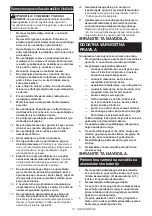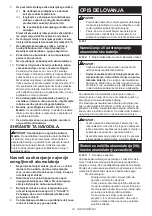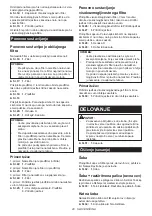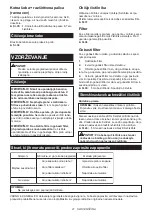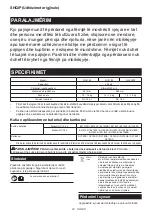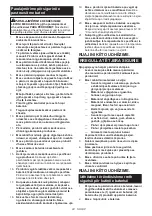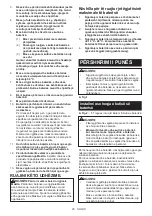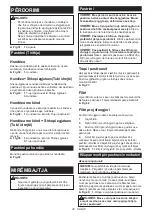
13 ENGLISH
Twist high performance filter in direction of arrow to unfas
-
ten securing lip from cleaner unit and then pull off the filter.
►
Fig.15:
1.
Securing lip
Clean out the fine dust and lightly tap to dislodge dust
from high performance filter.
Reassembly
Reassembly for normal filter
Put on filter until it is fully in position on the cleaner unit.
►
Fig.16:
1.
Filter
NOTE:
•
Make sure filter is put on straight without being
peeled back. If filter is put on incorrectly as
shown in diagram, dust will get into motor hous-
ing, and cause motor failure.
►
Fig.17:
1.
Filter
Connect prefilter. At this time, make sure to twist prefil
-
ter so that securing lip is firmly locked into cleaner unit.
►
Fig.18:
1.
Prefilter
►
Fig.19
Connect capsule. Align O symbol on capsule with O
symbol on handle and then firmly twist capsule in direc
-
tion of arrow until it is secured.
►
Fig.20:
1.
O Mark
►
Fig.21:
1.
Handle
2.
Capsule
NOTE:
•
Always remove dust ahead of time, as suction power
will be reduced if there is too much dust in cleaner.
•
Always be sure to check that both filter and pre
-
filter are loaded correctly prior to using cleaner.
If they are not loaded correctly, dust will get into
the motor housing, and cause motor failure.
If the following examples occur, filter and prefilter are not
loaded correctly. Reload them correctly to rectify problem.
Problem Examples
Example 1: Only prefilter has been loaded (no filter)
►
Fig.22:
1.
Prefilter
Example 2: Only filter has been loaded (no prefilter)
►
Fig.23:
1.
Filter
Example 3: Filter has been loaded in a peeled back state
►
Fig.24:
1.
Filter
Example 4: Prefilter's securing lip is not firmly locked
into groove of cleaner housing
►
Fig.25:
1.
Groove of cleaner housing
2.
Prefilter
3.
Securing lip
Reassembly for high performance filter
Connect high performance filter. At this time, make sure
to twist high performance filter so that securing lip is
firmly locked into cleaner unit.
►
Fig.26:
1.
High performance filter
2.
Securing lip
►
Fig.27:
1.
Securing lip
Connect capsule. Align O symbol on capsule with O symbol on handle
and then firmly twist capsule in direction of arrow until it is secured.
►
Fig.28:
1.
O Mark
►
Fig.29:
1.
Handle
2.
Capsule
NOTE:
•
Always remove dust ahead of time, as suction
power will be reduced if there is too much dust
in cleaner.
•
Always be sure to check that high performance
filter is loaded correctly prior to using cleaner. If
they are not loaded correctly, dust will get into
the motor housing, and cause motor failure.
If the following examples occur, high perfor-
mance filter is not loaded correctly. Reload them
correctly to rectify problem.
Problem Examples
Securing lip of high performance filter is not firmly
locked into groove of cleaner housing.
►
Fig.30:
1.
Securing lip
2.
Groove of cleaner housing
OPERATION
CAUTION:
•
To connect attachments, such as nozzle,
twist-insert attachment in direction of arrow to
ensure secure connection during use. To dis-
connect attachment, twist-extract also in direc-
tion of arrow.
If attachment is twisted in the opposite direction,
when being connected or disconnected, capsule
may become loose.
►
Fig.31:
1.
Capsule
Cleaning (Suction)
Nozzle
Attach the nozzle to clean off tables, desks, furniture,
etc. Nozzle slips on easily.
►
Fig.32:
1.
Nozzle
Extension wand (Straight pipe)
The extension wand fits in between the nozzle and the
cleaner itself. This arrangement is convenient for clean-
ing a floor while standing erect.
►
Fig.33:
1.
Cleaner body
2.
Extension wand
3.
Nozzle
Corner nozzle
Fit on the corner nozzle for cleaning corners and crev-
ices of a car or furniture.
►
Fig.34:
1.
Corner nozzle
2.
Cleaner body
Corner Extension wand
(Straight pipe)
In tight quarters where the cleaner itself cannot
squeeze in, or in high places hard to reach, use this
arrangement.
►
Fig.35:
1.
Corner nozzle
2.
Extension wand
3.
Cleaner body
Summary of Contents for DCL140
Page 2: ...1 2 3 1 1 1 1 2 1 2 3 2 1 Fig 1 Fig 2 Fig 3 Fig 4 Fig 5 Fig 6 Fig 7 Fig 8 2 ...
Page 3: ...1 2 1 2 1 2 1 2 1 2 2 1 1 1 Fig 9 Fig 10 Fig 11 Fig 12 Fig 13 Fig 14 Fig 15 Fig 16 3 ...
Page 4: ...1 1 1 1 2 1 1 1 Fig 17 Fig 18 Fig 19 Fig 20 Fig 21 Fig 22 Fig 23 Fig 24 4 ...
Page 5: ...1 2 3 1 2 1 1 2 1 1 2 1 1 Fig 25 Fig 26 Fig 27 Fig 28 Fig 29 Fig 30 Fig 31 Fig 32 5 ...
Page 6: ...1 2 3 1 2 1 2 3 1 2 Fig 39 Fig 33 Fig 34 Fig 35 Fig 36 Fig 37 Fig 38 6 ...
Page 7: ...1 1 2 3 Fig 41 2 3 1 4 2 1 1 2 1 2 Fig 45 Fig 40 Fig 42 Fig 43 Fig 44 7 ...
Page 8: ...2 1 3 Fig 46 8 ...

















